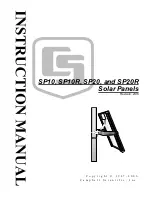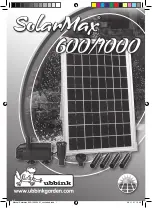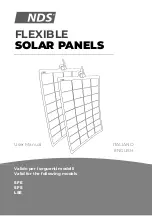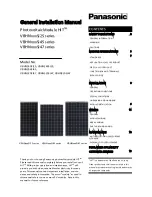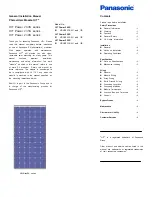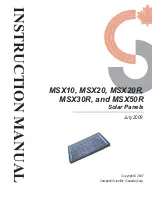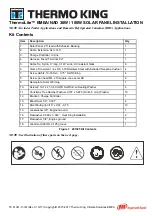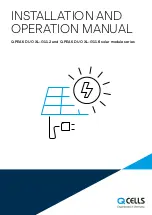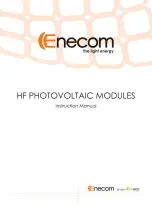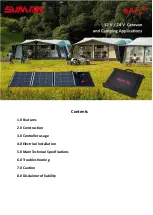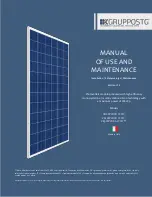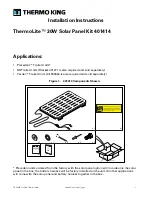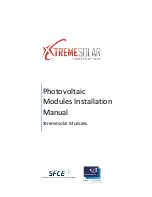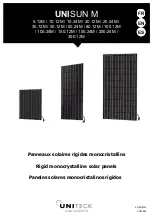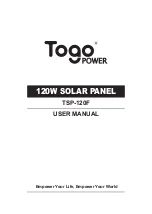
General Installation Manual
General Installation Manual for SANYO HIT Photovoltaic Modules. Please read this manual
completely before installation or use of SANYO modules. This manual applies to the following
products: HIP-205BA3, HIP-200BA3, HIP-195BA3, HIP-190BA3, HIP-186BA3, HIP-180BA3, HIP-
175BA3 and HIP-205BA5, HIP-200BA5, HIP-195BA5, HIP-190BA5, HIP-186BA5, HIP-180BA5
INTRODUCTION
Thank you for choosing SANYO HIT*
Photovoltaic (PV) modules. With proper
operation and maintenance, SANYO HIT
PV modules will provide you with clean,
renewable solar electricity for many
years. This manual contains important
installation, maintenance and safety
information. The word
“
module
”
as used
in this manual refers to one or more PV
modules. Retain this manual for future
reference.
Disclaimer of Liability
SANYO does not assume responsibility
and expressly disclaims liability for loss,
damage, or expense arising out of, or in
any way connected with installation,
operation, use, or maintenance by using
this manual. SANYO assumes no
responsibility for any infringement of
patents or other rights of third parties
which may result from use of modules.
No license is granted by implication or
under any patent or patent rights. The
information in this manual is believed to
be reliable, but does not constitute an
expressed and/or implied warranty.
SANYO reserves the right to make
changes to the product, specifications, or
manual without prior notice.
General Information
The installation of solar modules requires
a great degree of skill and should only be
performed by a qualified licensed
professional, including, without limitation,
licensed
contractors
and
licensed
electricians.
1
■
All instructions should be read
and understood before attempting to
install, wire, operate, and maintain the
photovoltaic module. Contact with
electrically active parts of the module
such as terminals can result in burns,
sparks, and lethal shock whether the
module is connected or disconnected.
© Sept. 2006 Sanyo Electric Co., Ltd.
All Rights Reserved
■
The installer assumes the risk of
all injury that might occur during
installation,
including,
without
limitation, the risk of electric shock.
■
PV modules generate DC electrical
energy when exposed to sunlight or
other light sources. Although single
modules produce only a low voltage
and current, shocks and burns are still
a potential hazard.
■
Do not carry a module by its
wires or junction box, to avoid the
hazard of electric shock, injury or
damage to the module.
■
Do not drop anything on the
surfaces of a module, to avoid the
hazard of electric shock, injury, and
damage.
■
To avoid the hazard of electric
shock and fire, be sure that all
other system components are
compatible, and they do not
subject the module to mechanical
or electrical hazards.
■
To avoid the hazard of electric
shock and injury, cover all of the front
surface of the PV modules with a
dense, opaque material such as the
cardboard box, during installation and
handling of the modules.
■
The shock hazard increases as
modules are connected in parallel
producing higher current. The
shock hazard increases as modules
are connected in series producing
higher voltages.
■
To avoid the hazard of electric
shock,
work
only
under
dry
conditions, with dry modules and
tools.
■
Do not stand or step on a
module to avoid the hazard of injury
and damage to a module.
■
Do not puncture or damage the
back-sheet of a module, to avoid the
hazard of electric shock and fire.
■
To avoid the hazard of electric
shock and injury, children and
unauthorized persons should not be
allowed near the installation of PV
modules.
■
To avoid the hazard of electric
shock and injury, be sure to
completely ground all modules.
■
To avoid the hazard of electric
shock, fire, and injury, do not
disassemble the module, or remove
any part installed by the
manufacturer.
■
Unauthorized persons--except
the qualified licensed professional--
should not open the cover of the
junction box to avoid the hazard of
electric shock.
Provide suitable guards to prevent
yourself from direct contact with 30
VDC or greater to avoid the hazard
of electric shock or injury.
■
When carrying a module, two
or more people should carry it by
its frame and wear non-slip gloves
(to avoid injury by a slipping
module, to a foot, or cuts by the
edge of a frame, and so on).
■
Since sparks may occur, do not
install the module where flammable
gases or vapors are present.
■
Never leave a module unsupported
or unsecured.
■
Do not drop a module.
■
Do not use or install broken
modules to avoid the hazard of
fire, electric shock, and injury.
■
Do not artificially concentrate
sunlight on a module to avoid the
hazard of fire or damage.
■
Do not touch the junction box
terminals to avoid the hazard of
electric shock and injury.
■
Do not change the wiring of
bypass diodes to avoid the hazard
of electric shock and injury.
■
Use a module for its intended
purpose only.
■
Do not treat the back sheet and
front surface with paint or adhesives
to avoid reducing its
’
functionality,
damage, inoperable conditions, and
other unknown troubles.
CAUTIONS
!
!
WARNING
!
!








